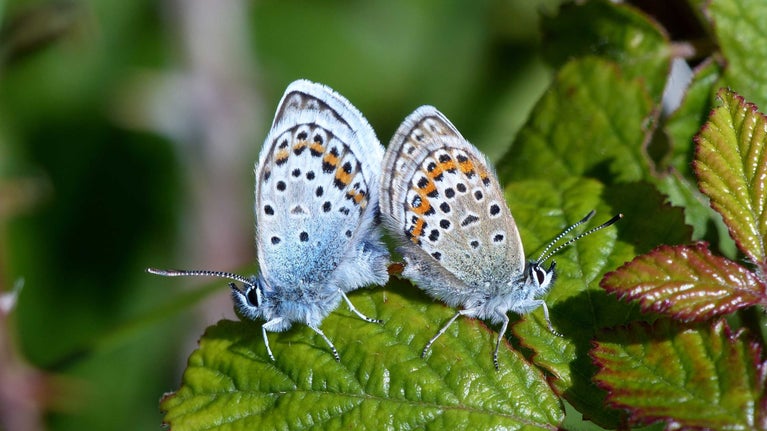Clean air and fire breaks help silver-studded blue butterflies go for gold as butterfly count at Dorset nature reserve sets new record
- Published:
- 16 September 2024

Butterfly experts have recorded the highest-ever numbers for silver-studded blue butterflies on the Studland heaths in Dorset, cared for by the National Trust, bucking the trend of an otherwise challenging year for butterflies.
During this year’s count, the team recorded 1,714 and 430 silver-studded blues along the two transects respectively, the highest ever recorded at either site.
For the latter transect, this is a 2047% increase from the first recorded butterfly numbers in 1976, where 21 butterflies were counted. Nationally, the rise has been just 45 percent.
The positive results are all the more outstanding in what has otherwise been a difficult year for butterflies in the UK, as numbers of early season butterflies in particular were poor due to the wet, cold weather and high winds.
Dr Martin Warren, one of the UK’s leading butterfly experts who has been counting butterflies at Studland as a volunteer for the past four years, said: “These figures really are something to celebrate, at a time when many butterflies aren’t faring well at all.
“The success is a testament to the work the team have been doing to manage the heathland in a way that creates the complex mosaic of different vegetation and bare ground that the silver-studded blues love.
Through this work, the Studland heath has become larger and better connected, creating a habitat where not only the silver-studded blues, but also other wildlife can thrive.
“The other factor that makes this such a special site is the clean air next to the sea and the low levels of nitrogen pollution that affects other heathlands. Heathlands thrive on poor soils and any extra nutrients can harm the delicate vegetation and ants on which the butterfly depends."
One vital part of the heathland management includes the maintenance of areas of short vegetation, which provides warm conditions for the black meadow ants that protect the butterfly larvae.
At Studland, which is also a popular destination for walkers, cyclists and horse riders, one key aspect of achieving this short vegetation is the long network of mown tracks going across the heaths to create fire breaks. Here, the visitor management team and the wildlife management team work closely together to manage access in a controlled way which helps maintain the paths without disturbing the wildlife and thereby helps create the right conditions for the butterflies.
Lead ecologist for the National Trust’s Purbeck Estate, David Brown explains: “It’s easy to think that wildlife conservation and providing access for visitors is inherently at odds with each other. What we are seeing at Studland is a great example that this does not need to be the case.
“There are access tracks that go through the main silver-studded blue areas, and it could be that the effect of visitors trampling keeping the vegetation low and creating patches of bare ground along paths actually helps create the conditions the butterflies – and the ants they depend upon – need.”
The monitoring at Studland has been carried out annually from April to September by a team of dedicated volunteers for almost 50 years. Starting in 1979, the counts have provided one of the most comprehensive data sets for butterfly conservation in the UK.
David continued: “Having nearly fifty years’ worth of data is a really unique position to be, as not many sites were set up with research in mind so early on. Now, we are able to use the long-term trends we have observed over the years to inform the decisions we make on how to best manage the heath, so that butterflies and other wildlife can continue to thrive here for many years to come.
“We are incredibly grateful to the volunteers who diligently carry out this important work across the NNR – without their consistent records, we wouldn’t have a clear picture of the state of nature in Purbeck.”
The work at Studland forms part of the conservation charity’s national ambition of creating and restoring priority habitats across the UK, of which it hit a milestone of 25,000ha only last month, nearly one year ahead of schedule.